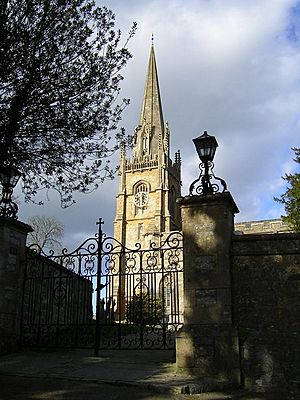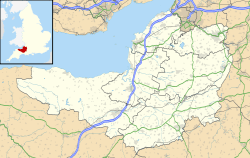Church of All Saints, Castle Cary facts for kids
Quick facts for kids Church of All Saints |
|
|---|---|
 |
|
| 51°05′12″N 2°31′00″W / 51.08667°N 2.51667°W | |
| Location | Castle Cary, Somerset |
| Country | England |
| Denomination | Church of England |
| Architecture | |
| Heritage designation | Grade II* listed |
| Designated | 24 March 1961 |
| Completed | c. 1470 |
| Administration | |
| Parish | Castle Cary and Ansford |
| Deanery | Bruton and Cary |
| Archdeaconry | Wells |
| Diocese | Bath and Wells |
The Church of All Saints is a historic church located in Castle Cary, a town in Somerset, England. This church was built around the year 1470. It is well-known for its tall steeple. The building is also recognized as a Grade II* listed building, which means it's a very important historical structure.
The church is part of the larger church area called the benefice of Castle Cary with Ansford. This area is overseen by the Archdeacon of Wells.
Contents
A Look at History
Early Beginnings
The Church of All Saints has a very old past. It actually started as a Saxon church. However, the original wooden building is no longer standing. The church you see today was built much later, around 1470. It was constructed in a style called Perpendicular Gothic.
Times of Change
During the English Civil War, which happened in the 1600s, the church suffered some damage. Its organ, a large musical instrument, was destroyed during this time.
A famous local person, James Woodforde, wrote about life in the church in his book, The Diary of a Country Parson. He was born in Ansford, where his father was the vicar (a type of priest). You can learn more about James Woodforde at the Castle Cary and District Museum.
Restoration Work
In the 1880s, the church was carefully repaired and updated. This work is called a Victorian restoration. An architect named Benjamin Ferrey led this project. He made the church's main area, called the nave, longer. This created more "free" seats for people to use. He also made the church tower taller.
Building Design
The Church of All Saints is built from local stone. Special cut stones from Doulting Stone Quarry were used for details. The roof is made of slate, and the top edges of the walls have a decorative, castle-like design called battlemented parapets.
The church has a tall tower with three sections. Inside the tower are six bells. These bells were made in 1760 by the Bilbie family, who were famous bell makers.
Inside the Church
When you go inside the church, you will find some very old items. There is a font, which is a basin used for baptisms. There is also a wooden pulpit, a raised stand where sermons are given. Both of these important pieces date back to the 15th century.
Churchyard Features
The churchyard is the area around the church where people are buried. Here, you can find the Cosenes monument. This monument is from the 16th century. It is currently listed on the Heritage at Risk Register, meaning it needs special care to protect it.
More to Explore
- List of ecclesiastical parishes in the Diocese of Bath and Wells


